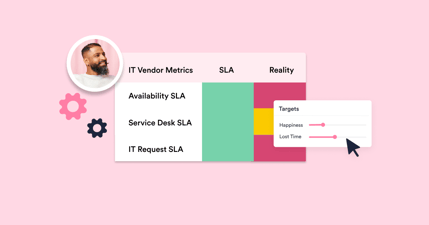The History of the Watermelon Effect in IT
This blog shares guidance on how to tackle the watermelon effect.

It’s hard to attend an IT industry conference or IT service management (ITSM) tool webinar without someone mentioning experience management. They might also call out the need for experience management in the context of something called “the watermelon effect.” This fruit-based symptom might feel like something new. However, as this blog will call out, while the name might be new to people, the issues it describes aren’t.
This blog also shares some guidance on how to tackle the watermelon effect. But first, we likely need to start with what the watermelon effect is.
The watermelon effect explained
The name might mean very little if you don’t eat watermelon. So, sorry if this is a “teaching grandparents to suck eggs” moment; watermelons are green on the outside and red on the inside. Hence, the term “watermelon effect” has been adopted to describe the situation where an IT organization consistently achieves its agreed performance targets and, just like the skin of a watermelon, IT’s performance dashboard and any internal reporting packs look green. All the service level targets have been met, and IT is thought to be doing well.
However, some employees (or end-users) disagree with this view of IT’s performance. They might struggle with their corporate IT or have received poor IT support experiences. They also likely think that the performance of the corporate IT organization is adversely affecting their personal and potentially business productivity. These employees view IT’s performance as red – just like the inside of a watermelon.
The IT organization is thus thought to have watermelon metrics. They appear green, but if you look under the surface, there’s only red.
But this “perception gap” is nothing new
While the term “watermelon effect” has become synonymous with the growth in experience management interest over the last decade, this perception disconnect between IT service providers and those who consume their services has long been known.
For example, Forrester Research data from Q4 2011 showed the disconnect or gap between what IT thought of their performance and their business-colleague view. The original Forrester chart likely can’t be reproduced because of its age (although the 2012 Forrester report that referenced 2011 data is still available – Forrsights: Business Execs Increase Direct IT Spend To Support Systems Of Engagement as is a blog for non-clients What’s The Real Cost Of Poor IT Support And Shoddy Customer Service? that references it). However, if you click through and view the graphic via either link, you’ll see that, and to quote the blog, “the business doesn’t rate IT very well (and sometimes IT doesn’t rate itself well).” Whether this is related to support, new technology research, innovation, business-centric services, or anything else included in the surveys. It was the watermelon effect before it was called “the watermelon effect”!
So, we’ve known about the disconnect between the business and IT views of IT performance for at least 13 years, but how many IT organizations still think they’re doing a great job because it’s what their metrics tell them? Plus, how long has this disconnect been there? ITIL ITSM best practice was born in 1989. It improved both IT service delivery and support. However, I’d still bet that there was still a gap between IT and their business colleagues’ perceptions. There was already a watermelon effect, with the perception gap likely widening as technology has become more critical to businesses and employees more explicit in their expectations of corporate IT.
People are generally smart enough to know there’s an issue
I believe that most people who work in IT realize that those they serve (employees and end-users) have a different view of IT than what IT performance metrics show. If nothing else, they hear things – whether at the water cooler or in service level management meetings. In terms of the watermelon effect, they likely knew there was an issue before it was called “the watermelon effect.”
However, for whatever reason, it was likely an issue that was left untouched. Perhaps bar via (continual) improvement activity. Service levels and service level agreements (SLAs) should have been part of the solution. However, it was easy for them to only add to the issue – service owners and potentially customer “champions” would agree to a level of service, and this was used (and still is) to show that IT is doing a great job.
Such SLAs might have been crafted with the best intentions and based on industry best practices. However, while they looked good on IT’s performance dashboards, they likely missed the many pain points experienced by employees. And it has taken until the growth in experience management for IT organizations to realize that their end-users are victims of the watermelon effect.
How experience data highlights the many factors contributing to the watermelon effect
This blog isn’t about the HappySignals The Global IT Experience Benchmark Report. However, its content is a good introduction to employees’ many issues with corporate IT services and support.
While some of the statistics are scary (the lost time and lost productivity levels), it’s important to remember that the experience data is aggregated from HappySignals customers who have already started their experience improvement journeys. It’s likely that the watermelon effect (and the issues that cause it) will be far worse in “an average IT organization.” For example, there might be even bigger issues with your organization’s “IT touchpoints” – from the IT self-service portal to enterprise applications and employee devices – than shown in the report.
There are also customer case studies that show how companies like Reckitt have used experience data to uncover hidden issues and drive improvements in IT service delivery and support.
Tackling the watermelon effect
We’ve another blog that offers guidance on tackling the watermelon effect, but here are some of its high-level practical tips:
- Appreciate that there’s likely a difference between the IT service provider and end-user perceptions of IT performance
- Understand the likely root cause(s) of the “perception gap” based on industry insight
- Identify and involve the right business stakeholders
- Initiate data-driven changes with specific goals in mind
- Manage people’s expectations
- Recognize that experience targets will change over time
- Appreciate that experience-data-driven change needs experience data to measure success.
It’s not stated explicitly in the above, but the data-driven changes will require that your organization understands how its employees feel about the IT services they receive.
Find out more about the watermelon effect and how experience data helps here.
Related content

16.05.2024
Practical Tips for Addressing the “Watermelon Effect”
Most IT service management (ITSM) professionals will have heard or read about the increasing importance of their IT ...
Read more >
18.09.2024
Why CIOs Need to Care About the Watermelon Effect
CIOs usually have a lot on their plate, especially given the ever-growing importance of technology to business ...
Read more >
